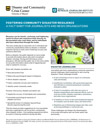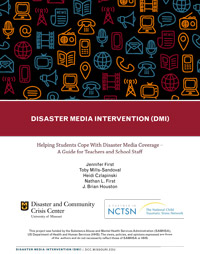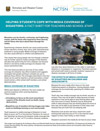Media and Journalists
The Disaster and Community Crisis Center has developed resources to help youth, families, and professionals cope with media coverage of disasters. DCC also has materials for journalists to use when covering disasters.
DCC Resources
- Helping Your Child Cope with Media Coverage of Community Racial Trauma
-
Media coverage of community racial trauma and civil unrest can cause children to experience fear, worry, sadness, confusion, and anger. This video provides strategies for parents to help reduce distress your child may be experiencing resulting from media coverage of community racial trauma and civil unrest.
View the community racial trauma media video for parents HERE.
- Helping Youth Cope with Media Coverage of a Disaster: A Fact Sheet for Parents
-

This fact sheet provides an overview of how media coverage of a disaster may affect youth and suggests strategies that parents can use to address these effects.
Download the disaster media fact sheet for parents HERE in English and HERE in Spanish.
View the disaster media video for parents HERE.
- Fostering Community Disaster Resilience: A Fact Sheet for Journalists and News Organizations
-

This fact sheet provides suggestions for how journalists and news organizations can serve their communities when disaster strikes – from guiding preparations before an event to fostering resilience during and after.
Download the disaster journalism fact sheet HERE in English and HERE in Spanish.
- The Disaster and Media Intervention (DMI)
-

The Disaster Media Intervention (DMI) is designed to help students cope with disaster media coverage.
DMI equips teachers, counselors, social workers, administrators, and other school staff to facilitate conversations with students about these media-covered disasters, whether they occur locally or far away.
Click HERE for more information.
- Helping Youth Cope with Media Coverage of Disaster: A Fact Sheet for Teachers
-

This fact sheet provides an overview of how media coverage of a disaster may affect students and suggests strategies that teachers can use to help students cope with disaster media coverage.
Download the disaster media fact sheet for teachers HERE in English and HERE in Spanish.
View the disaster media video for school staff HERE.
